Overview of RC System Antennas
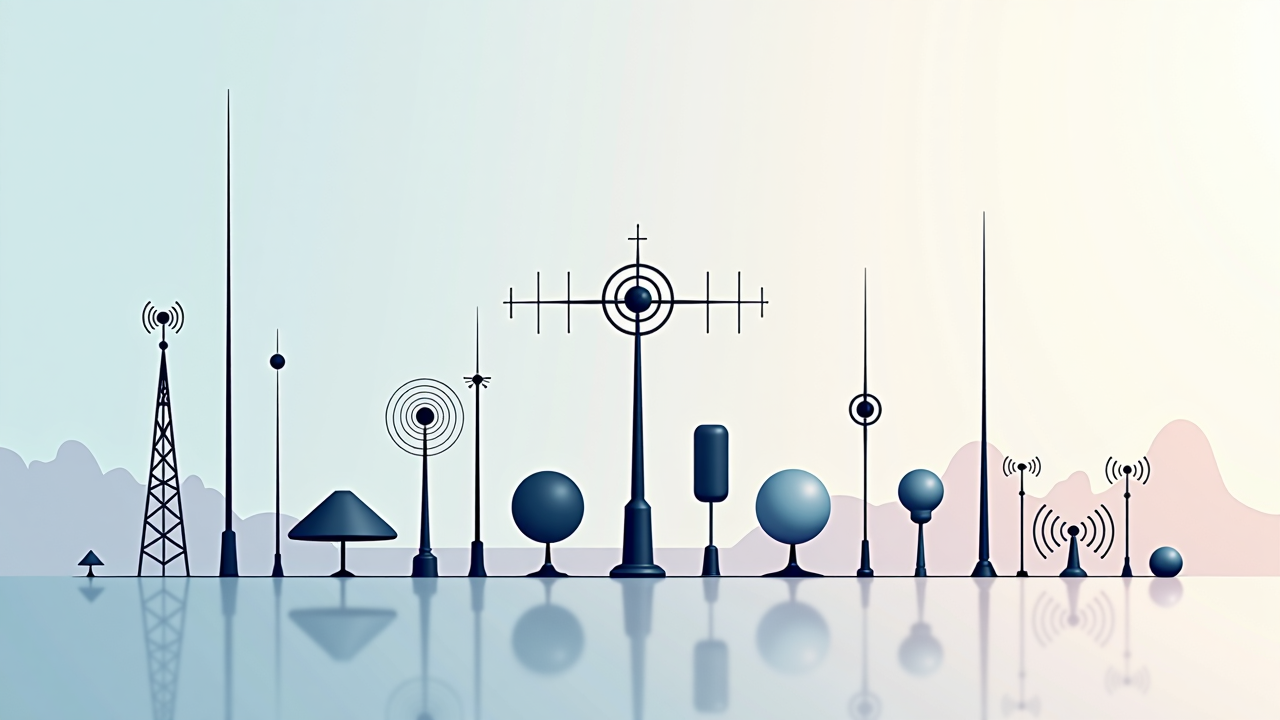
The antenna system is the critical link in your drone's control chain, determining range, reliability, and resistance to interference. While video breakup is inconvenient, control signal loss can be catastrophic. After years of testing countless antenna configurations across various environments, I've compiled this comprehensive guide to help you understand, select, and optimise your control system antennas for maximum performance and reliability.
Introduction to Control System Antennas
I've seen many pilots obsess over video antennas while neglecting their control link — a mistake I made myself when starting out. Control system antennas serve a fundamentally different purpose than video antennas, operating on different frequencies and with different priorities:
- Video systems typically operate at 5.8GHz and prioritise bandwidth for transmitting complex video data
- Control systems operate at lower frequencies (2.4GHz, 900MHz, 433MHz) and prioritise reliability and low latency for critical control commands
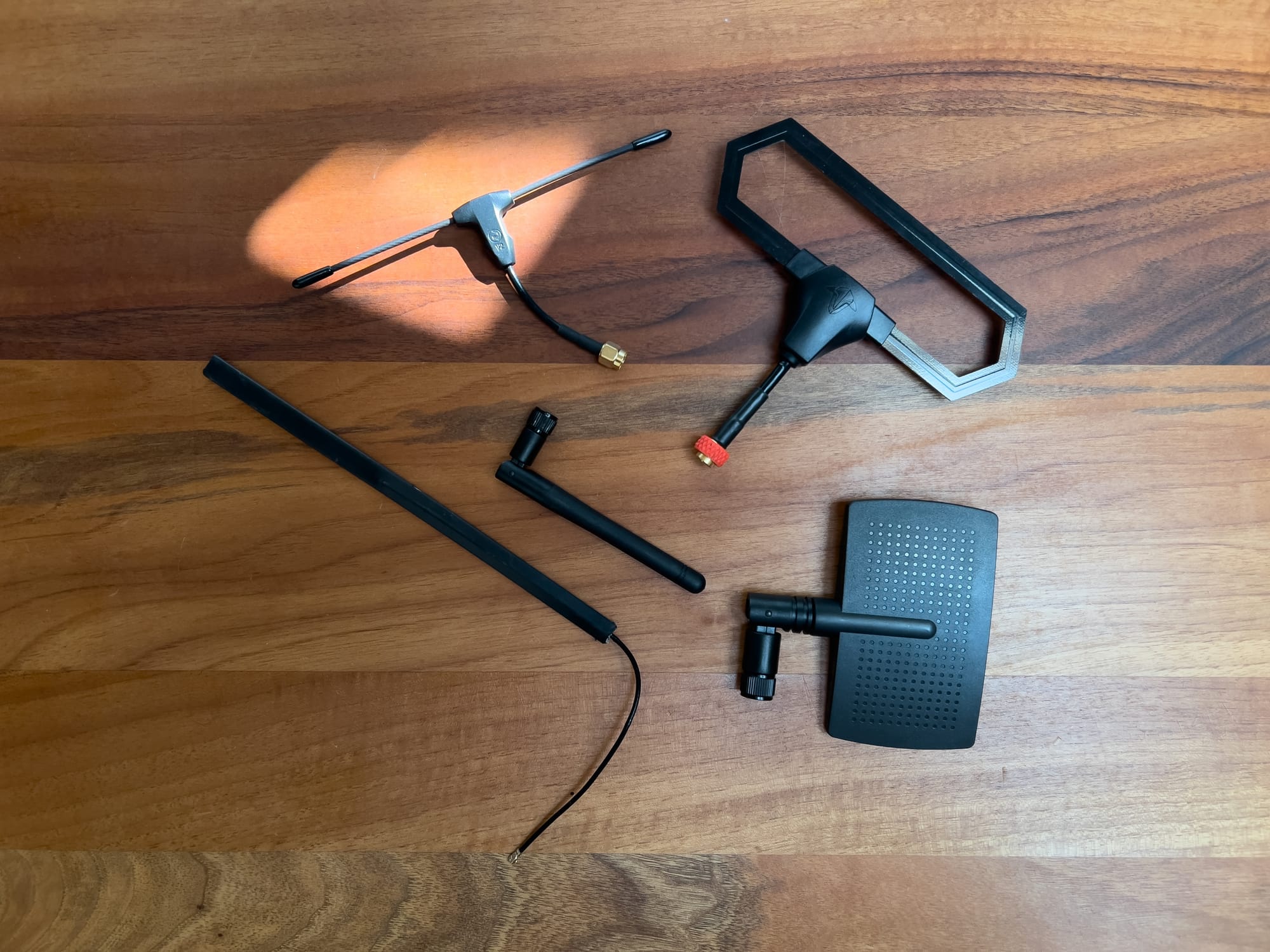
Understanding these differences is essential for selecting and optimising the right antennas for your control system.
The Evolution of Control System Technology
Control systems have evolved dramatically over the years:
- Early Days: The first RC systems used simple AM/FM technology with basic whip antennas and limited range
- Spread Spectrum Revolution: The introduction of 2.4GHz FHSS/DSSS systems around 2005 dramatically improved reliability and reduced interference
- Long-Range Systems: The development of 900MHz and 433MHz systems opened new possibilities for extreme range
- Modern Advancements: Today's systems like ExpressLRS, Crossfire, and Ghost offer unprecedented range, reliability, and features
Each evolution in technology has brought new antenna requirements and opportunities for optimization.
The Critical Role of Control Antennas
In my years of flying, I've learned that control antennas are arguably more important than video antennas for several reasons:
- Safety: Loss of control can lead to crashes and potential damage or injury
- Legal Liability: Maintaining positive control is a regulatory requirement in most jurisdictions
- Aircraft Preservation: Even with video loss, proper control can allow safe recovery
- Range Limitation: Control range often defines the practical limit of your flight envelope
I've witnessed many pilots lose drones because they invested heavily in video systems while neglecting their control link. Don't make this common mistake!
Basic Antenna Principles for Control Systems
Several fundamental concepts govern antenna performance that I've found crucial to understand:
Frequency and Wavelength
The frequency of your control system determines the optimal antenna length and characteristics:
- 2.4GHz: Wavelength ~125mm, resulting in compact antennas
- 900MHz/868MHz: Wavelength ~333mm, requiring larger antennas
- 433MHz: Wavelength ~693mm, necessitating much larger antennas
The relationship between frequency and antenna size is inverse—lower frequencies require larger antennas but offer better penetration and range. I've found this trade-off to be one of the most important considerations when building a drone for specific purposes.
Antenna Gain and Radiation Pattern
Gain refers to an antenna's ability to focus energy in specific directions:
- Higher gain: More focused radiation pattern, greater range in specific directions
- Lower gain: More uniform radiation pattern, better coverage at closer ranges
For control systems, I've learned through experience that the ideal radiation pattern depends on your flying style:
- Omnidirectional patterns are better for freestyle and proximity flying where the drone moves in unpredictable directions
- Directional patterns can extend range for long-range flights where the drone remains in a general direction from the pilot
I once lost a drone because I was using a high-gain directional antenna on my transmitter during a freestyle session. When the drone drifted behind me, it flew straight into my antenna's null zone, causing an immediate failsafe. Learn from my mistake!

Polarisation for Control Systems
Polarisation describes the orientation of the electromagnetic waves:
- Linear Polarisation: Waves oscillate in a single plane (vertical or horizontal)
- Circular Polarisation: Waves rotate as they propagate (clockwise or counterclockwise)
While circular polarisation is common for video systems, I've found that control systems often use:
- Linear polarization for maximum efficiency and simplicity
- Circular polarization when multipath interference is a significant concern
In my testing, linear polarisation typically provides about 3dB (50%) more efficiency when perfectly aligned, but circular polarisation maintains more consistent performance when the drone is performing acrobatic manoeuvres.
Types of Control System Antennas
Different control systems use various antenna types optimized for their specific frequencies and requirements. I've tested dozens of configurations to find what works best in various scenarios.
2.4GHz Control System Antennas
The most common frequency for FPV control systems, 2.4GHz offers a good balance of range, antenna size, and performance.
Dipole/Monopole Antennas
The simplest and most common 2.4GHz antennas:
Characteristics:
- Linear polarisation
- Moderate gain (2-2.5dBi)
- Simple "stick" design
- Omnidirectional pattern on horizontal plane
- Null points directly above and below
Best For:
- Standard range applications
- Freestyle and racing
- Situations where simplicity is valued
Examples:
- Stock antennas on most transmitters
- Basic receiver antennas
- T-style receiver antennas
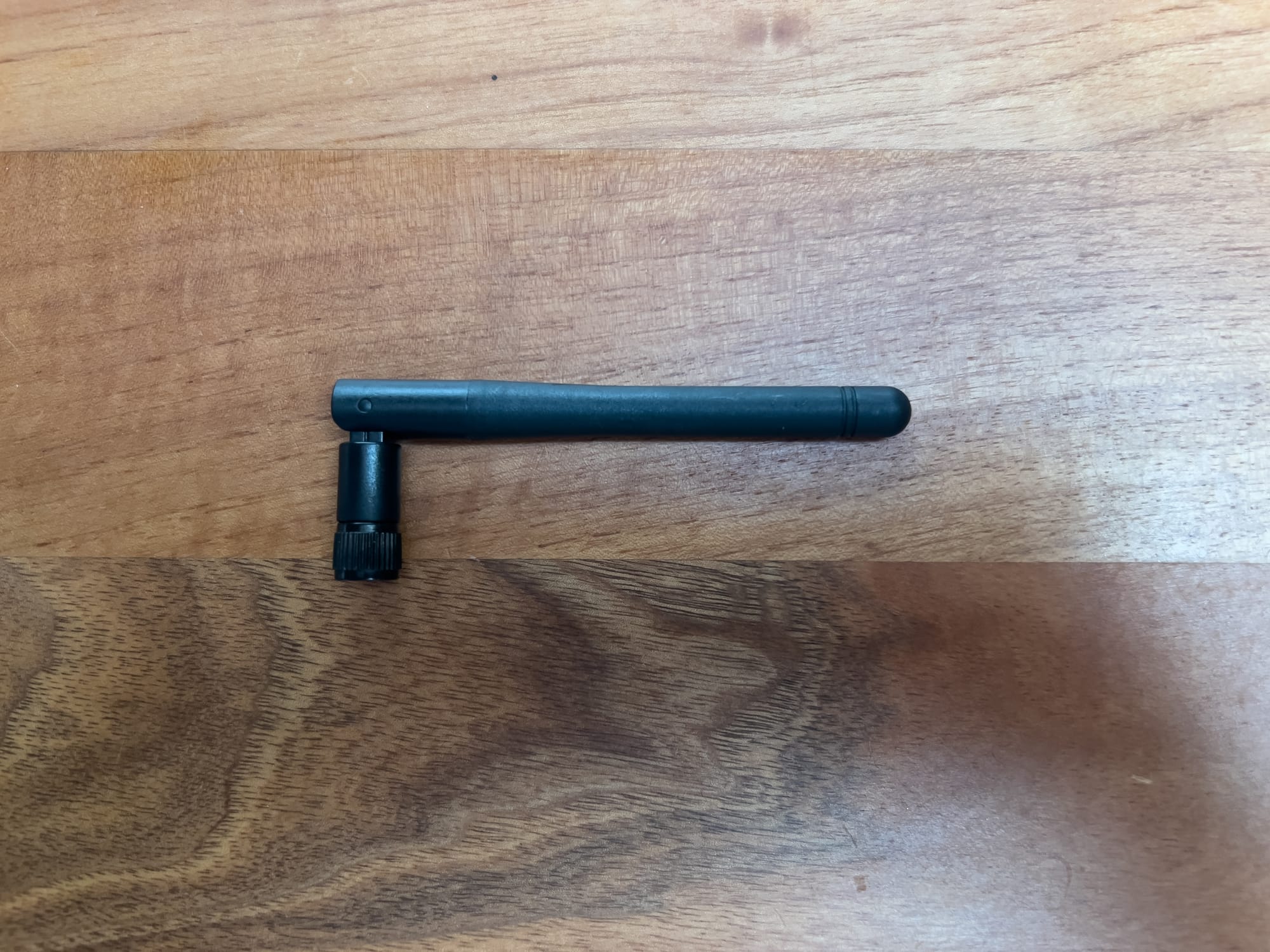
I've found that stock dipole antennas work surprisingly well for most flying within 1-2km. Don't underestimate them! The key is proper orientation and placement rather than rushing to upgrade.
Enhanced 2.4GHz Antennas
Improved designs for better performance:
Diamond Antennas
Characteristics:
- Linear polarization
- Higher gain (3-4dBi)
- Diamond-shaped design
- Better radiation pattern than simple dipoles
- Reduced null points
Best For:
- Improved range over stock antennas
- Transmitter upgrades
- Maintaining omnidirectional coverage with better performance
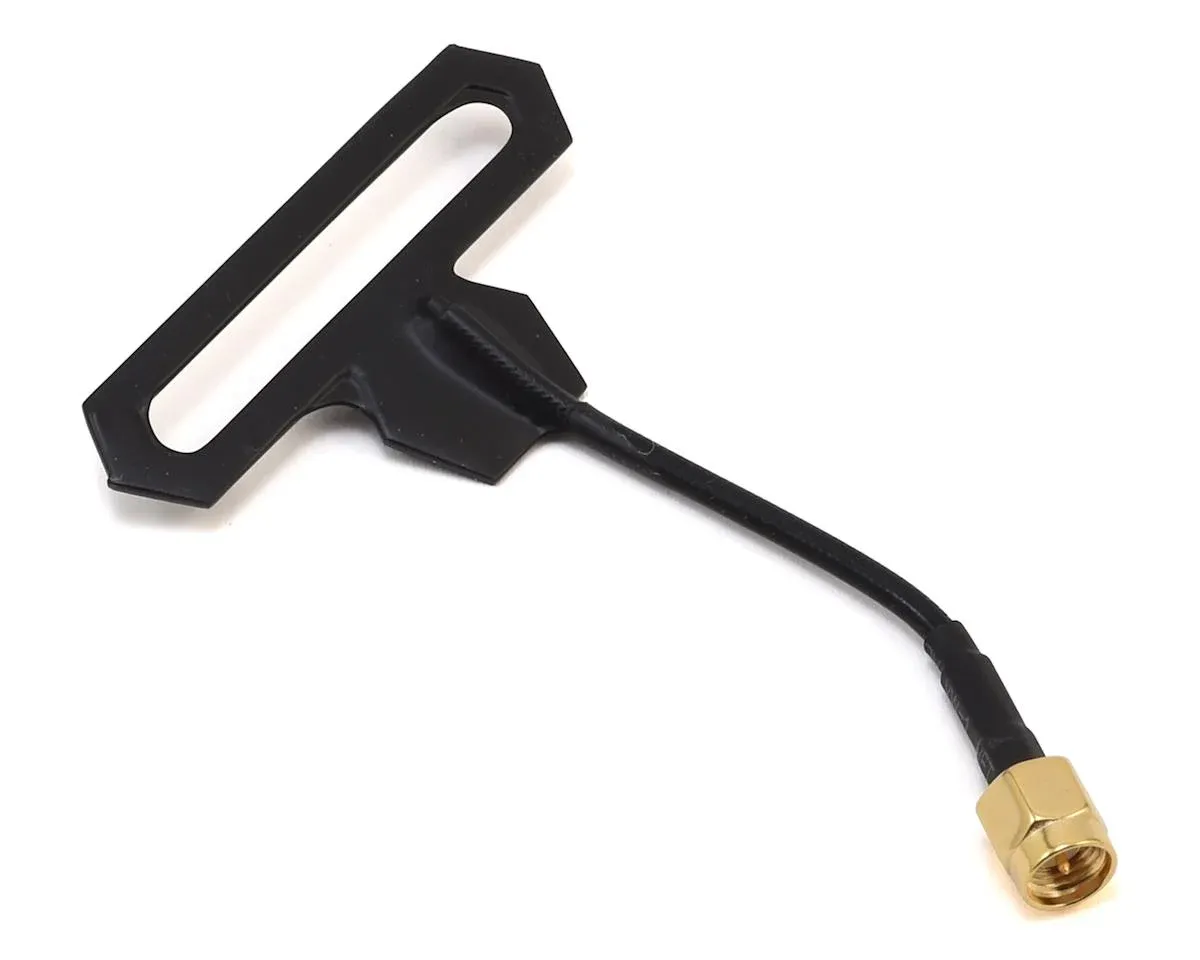
I've gained approximately 20-30% more range by switching from stock dipoles to quality diamond antennas on my transmitter. The improvement is most noticeable when flying at the edge of your range.
Patch Antennas for 2.4GHz
Characteristics:
- Directional pattern
- High gain (7-9dBi)
- Flat, rectangular design
- Available in both linear and circular polarization
- Beamwidth typically 60-120 degrees
Best For:
- Long-range 2.4GHz systems
- Fixed ground stations
- Directional applications
Examples:
- ExpressLRS directional antennas
- Ghost system long-range antennas
- Aftermarket transmitter upgrades
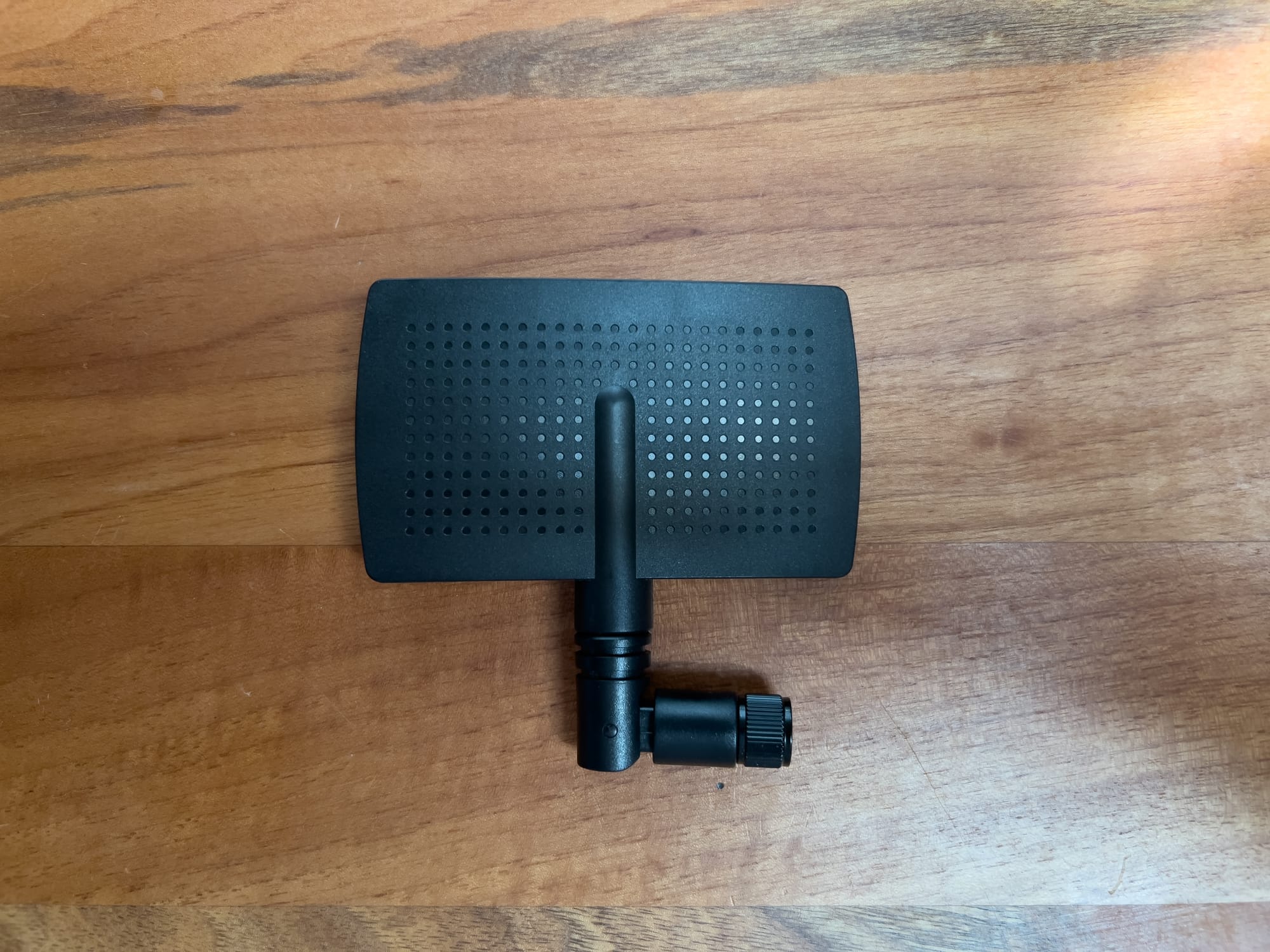
When I'm doing dedicated long-range flights, a patch antenna on my transmitter can nearly double my effective range compared to an omnidirectional antenna. The trade-off is that I need to keep the drone in front of me within the antenna's coverage area.
900MHz/868MHz Control System Antennas
These lower frequencies offer superior range and penetration but require larger antennas. These are game-changers for long-range flying.
Dipole/Monopole 900MHz Antennas
Basic antennas for 900MHz systems:
Characteristics:
- Linear polarization
- Moderate gain (2-2.5dBi)
- Longer length than 2.4GHz equivalents (~8cm)
- Omnidirectional pattern on horizontal plane
- Flexible designs to accommodate size
Best For:
- Standard range 900MHz systems
- Receiver installations where space permits
- General-purpose applications
Examples:
- TBS Crossfire receiver antennas
- FrSky R9 antennas
- ExpressLRS 900MHz antennas
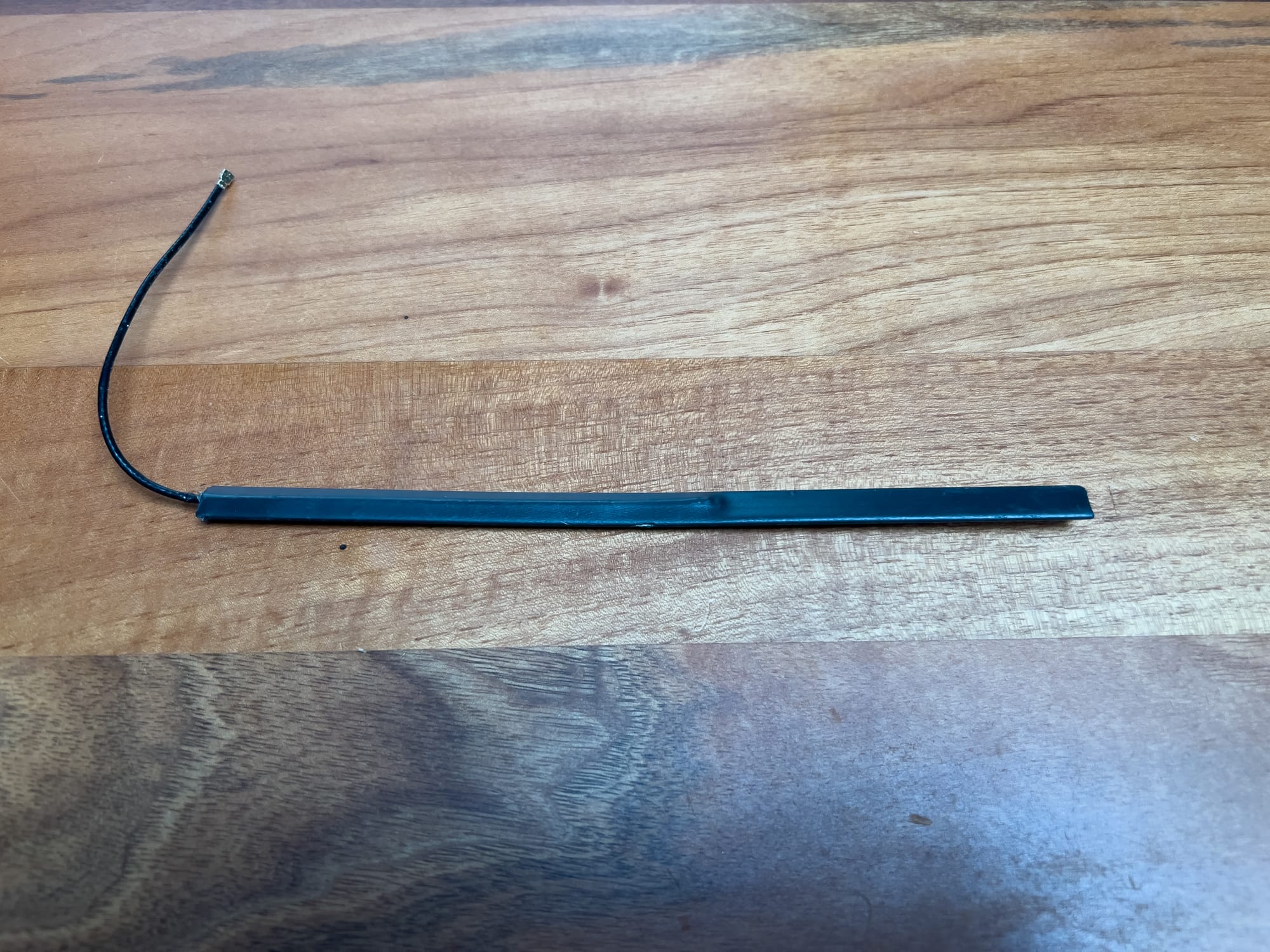
Even basic 900MHz antennas outperform most 2.4GHz setups for penetration through obstacles. I've maintained control through dense forest where 2.4GHz systems fail completely. The challenge is finding space for these larger antennas on smaller builds.
Enhanced 900MHz Antennas
Specialized designs for improved performance:
Immortal-T Style Antennas
Characteristics:
- Linear polarization
- Moderate gain (2.5-3dBi)
- T-shaped design
- Better radiation pattern than simple dipoles
- Durable construction
Best For:
- Improved performance over stock antennas
- Drone-mounted receivers
- Balance of performance and size
Examples:
- TBS Immortal-T
- Crossfire antenna upgrades
- ExpressLRS performance antennas
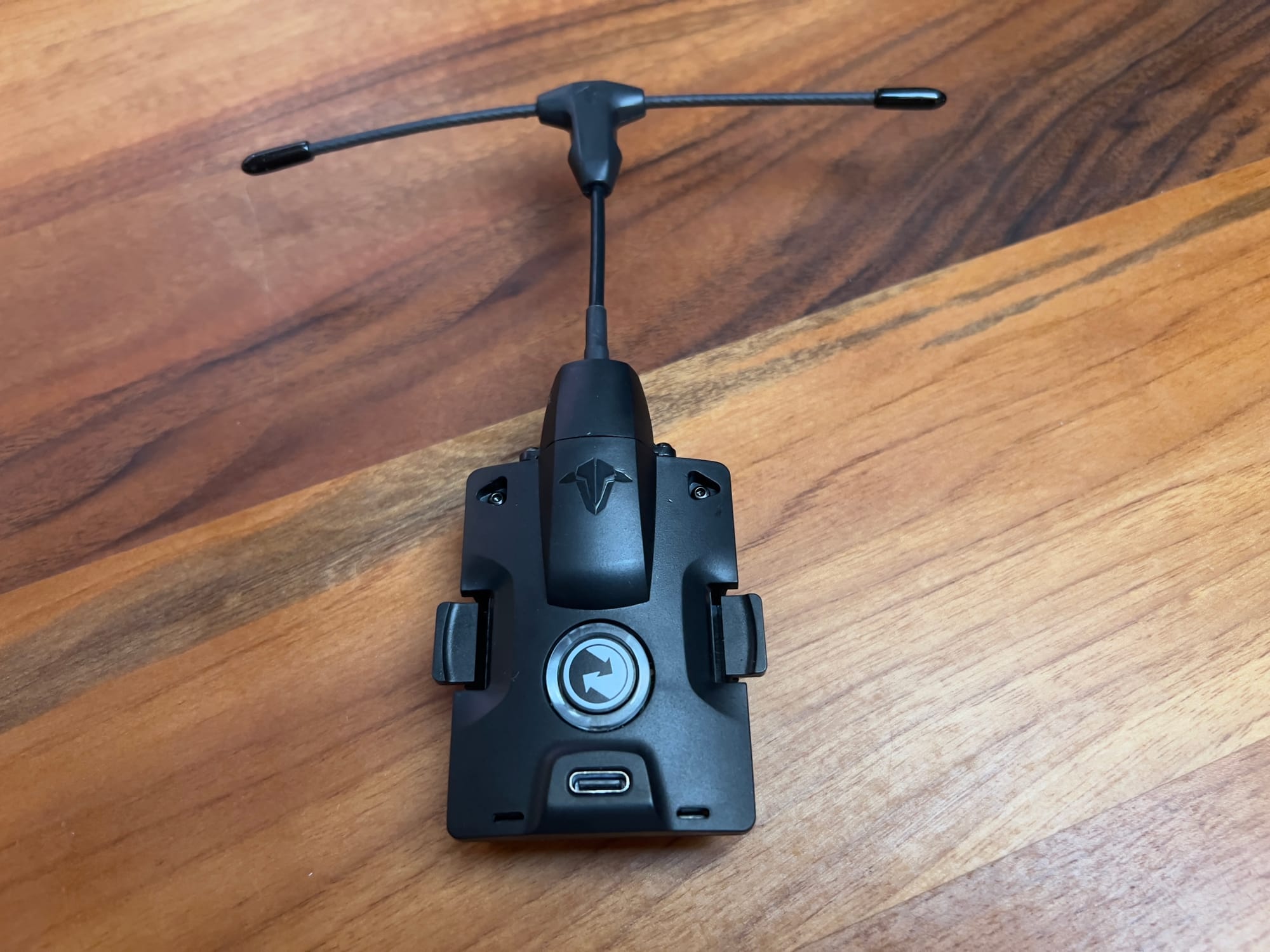
The Immortal-T design has saved countless drones for me. Not only does it provide better performance than simple dipoles, but its durability in crashes is exceptional. I'd consider it the standard upgrade for any 900MHz system.
Directional 900MHz Antennas
Characteristics:
- High gain (8-12dBi)
- Directional pattern
- Various designs (Yagi, patch, helical)
- Significantly larger size
- Excellent long-range performance
Best For:
- Maximum range applications
- Fixed ground stations
- Antenna tracker systems
Examples:
- TBS Crossfire Yagi
- DIY 900MHz directional antennas
- Commercial long-range antennas

When I'm pushing for maximum range, a directional 900MHz antenna on my transmitter has allowed me to maintain control beyond 20km in ideal conditions. The key is keeping the drone within the antenna's beam, which often requires an antenna tracker for practical use.
433MHz Control System Antennas
The lowest common frequency for FPV control, 433MHz offers maximum range but requires the largest antennas. This is the domain of serious long-range enthusiasts.
Basic 433MHz Antennas
Characteristics:
- Linear polarization
- Simple wire design
- Considerable length (~16-17cm)
- Omnidirectional pattern
- Often flexible to accommodate size
Best For:
- Standard range 433MHz systems
- Applications where antenna size is not critical
- General-purpose use
Examples:
- DragonLink receiver antennas
- ImmersionRC UHF antennas
- ExpressLRS 433MHz basic antennas

The first time I flew with a 433MHz system, I was amazed at how it maintained solid control link through dense forest and around terrain features. The challenge is finding creative ways to mount these long antennas on your drone without them getting damaged in crashes.
Enhanced 433MHz Antennas
Specialized designs for maximum range:
Dipole Arrays
Characteristics:
- Multiple dipoles in specific arrangements
- Higher gain (4-6dBi)
- Improved radiation pattern
- Larger size but better performance
- Often semi-directional
Best For:
- Improved range without full directionality
- Transmitter upgrades
- Fixed orientation flying

Dipole arrays offer a nice middle ground between simple antennas and fully directional designs. I've found them particularly useful for long-range flights where I want better range than a simple dipole but don't want the hassle of constantly aiming a highly directional antenna.
Directional 433MHz Antennas
Characteristics:
- Very high gain (10-15dBi)
- Highly directional pattern
- Large physical size
- Excellent extreme range performance
- Various designs (Yagi, helical)
Best For:
- Maximum possible range
- Fixed ground stations
- Antenna tracker systems
Examples:
- DragonLink Yagi antennas
- UHF long-range directional antennas
- DIY extreme range antennas

With a high-gain directional 433MHz antenna and clear line of sight, I've managed to maintain control at distances exceeding 50km. At this point, battery capacity and legal restrictions become the limiting factors rather than radio range.
Antenna Selection Guide for Control Systems
Choosing the right control system antennas depends on your specific needs, flying style, and control system. After years of testing different combinations, here are my recommendations:
Based on Control System Type
For ExpressLRS
Transmitter Antennas:
- 2.4GHz: Stock dipole for general use, diamond for improved range, directional for maximum range
- 900MHz: Immortal-T style for general use, directional for maximum range
- 433MHz: Stock dipole for general use, directional for extreme range
Receiver Antennas:
- 2.4GHz: T-style dipole for most builds, diversity setups for improved reliability
- 900MHz: Immortal-T style for balance of size and performance
- 433MHz: Full-length dipole for best performance, shortened versions for space-constrained builds
I've found ExpressLRS to be exceptionally tolerant of less-than-ideal antenna setups. Even with the stock antennas, it outperforms many other systems with upgraded antennas. That said, proper antenna selection and placement still make a significant difference in challenging environments.
For TBS Crossfire/Tracer
Transmitter Antennas:
- Crossfire (900MHz): Immortal-T for general use, directional for maximum range
- Tracer (2.4GHz): Stock antenna for general use, diamond for improved range
Receiver Antennas:
- Crossfire: Immortal-T for standard builds, diversity setups for critical applications
- Tracer: T-style dipoles, diversity setups for improved reliability
Crossfire's Immortal-T antenna design is one of the best innovations in control system antennas. It provides an excellent balance of performance and durability. I've crashed countless times on Immortal-T antennas without damage, where traditional dipoles would have snapped.
For Ghost
Transmitter Antennas:
- Stock antenna for general use, upgraded dipole for improved range
Receiver Antennas:
- Standard dipoles, optimized for specific receiver models
Ghost's stock antennas are exceptionally well-designed. I've found less benefit from aftermarket upgrades with Ghost compared to other systems, though proper placement and orientation remain critical.
For FrSky Systems
Transmitter Antennas:
- ACCST/ACCESS (2.4GHz): Stock dipole for general use, aftermarket upgrades for improved range
- R9 (900MHz): Stock antenna for general use, directional for maximum range
Receiver Antennas:
- 2.4GHz: Standard dipoles, diversity options for XM+ and R-XSR
- R9: Super 8 and T-style antennas for different applications
FrSky systems benefit significantly from antenna upgrades. I've seen 30-50% range improvements with quality aftermarket antennas compared to the stock options. The diversity options on receivers like the R-XSR make a noticeable difference in challenging environments.
Based on Flying Style
For Racing
Priority: Reliability and consistent performance at medium ranges
Recommended Antennas:
- Transmitter: Standard dipole or diamond antenna
- Receiver: T-style dipoles with proper orientation
- Considerations: Antenna durability and placement to survive crashes
For racing, I prioritise consistency over maximum range. A simple, well-positioned antenna setup is often better than complex configurations that might get damaged in the inevitable crashes. I've found that 2.4GHz systems with quality omnidirectional antennas provide the best balance for most race courses.
For Freestyle
Priority: Reliable omnidirectional coverage
Recommended Antennas:
- Transmitter: Enhanced omnidirectional (diamond or upgraded dipole)
- Receiver: T-style or diversity setups
- Considerations: Balance of performance and durability
Freestyle flying demands omnidirectional coverage since your drone can be in any orientation or direction relative to you. I've found that diversity receiver setups make a significant difference in preventing failsafes during aggressive maneuvers, especially when flying around obstacles.
For Long Range
Priority: Maximum range and reliability
Recommended Antennas:
- Transmitter: Directional antenna (possibly on tracker) + omnidirectional for close range
- Receiver: Highest quality omnidirectional antenna with optimal placement
- Considerations: Lower frequency systems (900MHz/433MHz) with appropriate antennas
For serious long-range flying, I've found that frequency selection is even more important than antenna selection. A basic 433MHz setup will often outperform an optimized 2.4GHz system. That said, combining lower frequencies with high-gain directional antennas provides the ultimate range.
For Micro Builds
Priority: Compact size with adequate performance
Recommended Antennas:
- Transmitter: Standard for the system
- Receiver: Compact antennas designed for the specific system
- Considerations: Proper orientation despite space constraints
With micro builds, I've learned that orientation is even more critical than antenna type. Even a shortened antenna properly oriented will outperform a full-size antenna in a poor position. For tiny whoops, I focus on keeping at least one antenna segment vertical, even if I have to shorten the antenna.
Antenna Installation and Optimisation
Proper installation is as important as antenna selection for maximizing performance. I've seen countless pilots with excellent equipment get poor results due to improper installation.
Transmitter Antenna Installation
Orientation and Positioning
- Hold the transmitter naturally during setup to ensure proper antenna orientation during flight
- Position antennas vertically when possible for best coverage of a drone flying in front of you
- For directional antennas, point directly at the flying area or use a tracking system
- Avoid blocking antennas with your body or hands
I've found that many pilots don't realise how much their body blocks RF signals. I always position my transmitter antenna so it has clear line of sight to my drone, which sometimes means holding the transmitter higher or to the side of my body rather than directly in front of me.
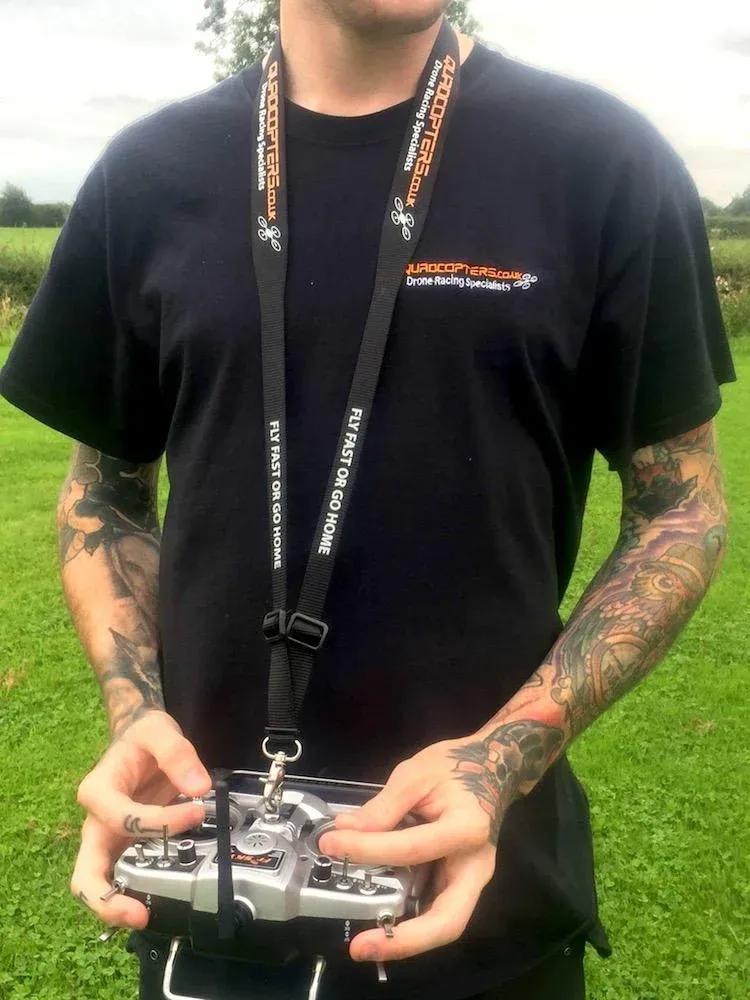
Antenna Upgrades
When upgrading transmitter antennas:
- Match the connector type (typically SMA or RP-SMA)
- Verify compatibility with your specific transmitter module
- Consider using extension cables for better positioning
- Ensure proper mounting to prevent damage to connectors
I've damaged expensive radio equipment by forcing incompatible connectors together. Always verify whether your system uses SMA or RP-SMA connectors before purchasing upgrades. They look nearly identical but are not compatible without adapters.
Receiver Antenna Installation
Orientation and Positioning
The most critical aspect of control system antenna installation:
- If using multiple antennas, position receiver antennas at 90° angles to each other for diversity
- Keep antennas away from carbon fiber, metal, and power components
- Maintain proper polarization (typically vertical for linear polarized antennas)
- Route antennas along non-conductive parts of the frame
- Use antenna tubes to protect and position antennas properly
I've recovered from complete video loss many times thanks to properly installed control antennas. The 90° orientation is absolutely critical — I've seen range reductions of 70% or more when both antennas are parallel to each other.
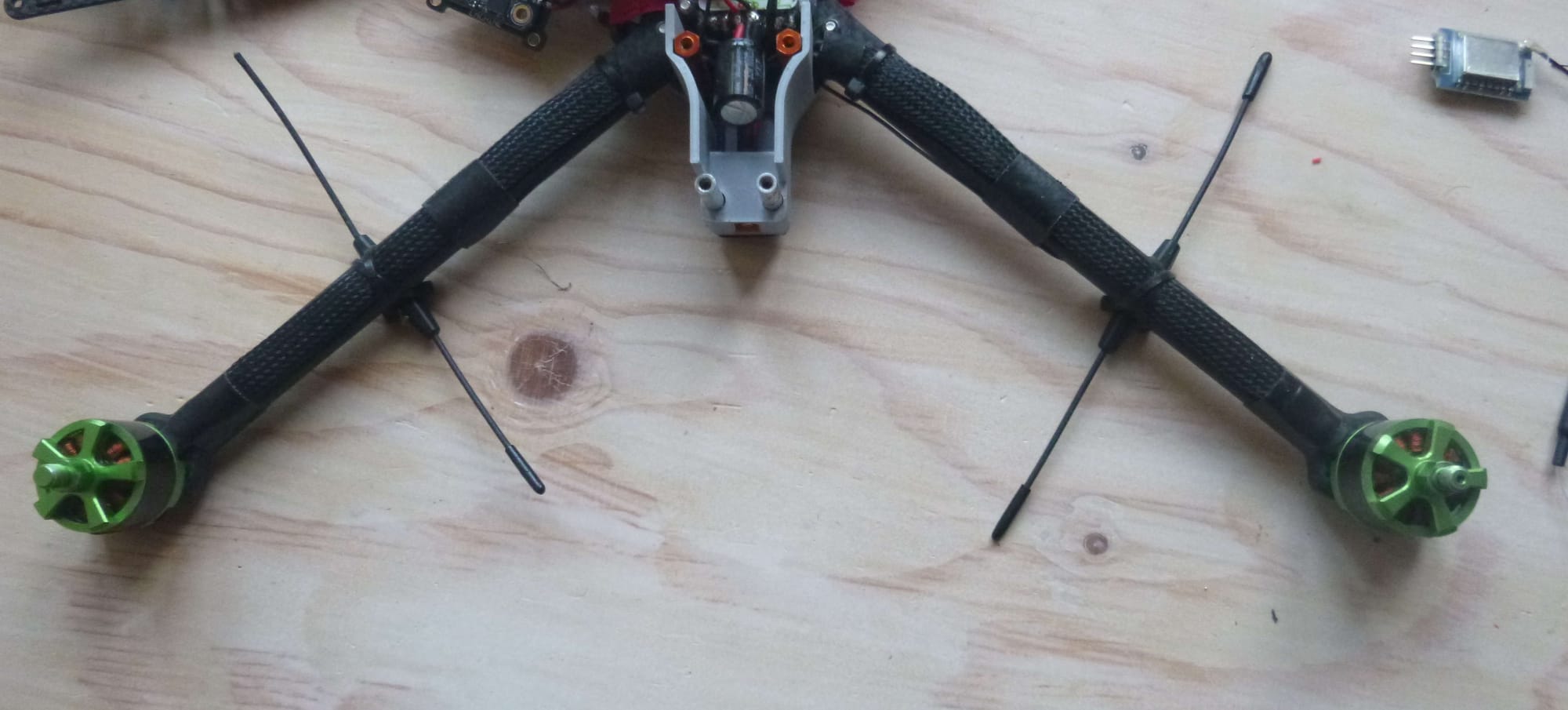
Common Mounting Methods
- Zip-tie mounts: Secure antennas to non-conductive frame parts
- Antenna tubes: Rigid tubes that protect and position antennas
- 3D printed mounts: Custom solutions for specific frames
- Skid mounts: Positioning antennas on landing gear
- TPU antenna holders: Flexible mounts that absorb impact
After trying countless mounting methods, I've settled on 3D printed PLA mounts for most of my builds. They provide the perfect balance of secure positioning and crash resistance. For micro builds where every gram counts, I use lightweight zip-tie mounts instead.
Antenna Cables and Connectors
The connection between receiver and antenna is a potential weak point:
- Use high-quality, low-loss coaxial cable for any extensions
- Keep cable runs as short as possible
- Secure connections to prevent vibration damage
- Use appropriate strain relief to protect connectors
- Consider conformal coating connectors for weather protection
I've lost more drones to connector failures than to actual antenna problems. A quality connector properly secured will outlast multiple antennas. I always add a small dab of silicone to secure connections and provide strain relief, which has prevented countless failures.
Common Connector Types for Control Systems
- U.FL/IPEX: Tiny connectors used on many receivers
- MMCX: Small snap-on connectors with better retention than U.FL
- SMA: Threaded connectors used on larger receivers and transmitters
- RP-SMA: Reverse polarity SMA, common on many systems

U.FL connectors are the most common point of failure in my experience. They're designed for only a few connection cycles, so I try to avoid disconnecting them whenever possible. For builds that I modify frequently, I prefer receivers with MMCX or SMA connectors when available.
For more detailed information on connectors, see:
Overview of RF Connector Types
Advanced Antenna Concepts
For experienced pilots looking to optimize their control systems, these advanced concepts provide deeper insights that I've gained through years of testing.
Antenna Diversity Systems
Diversity uses multiple antennas to improve reception:
- True Diversity: Multiple complete receiver circuits that select the strongest signal
- Antenna Diversity: Multiple antennas connected to a single receiver
- Spatial Diversity: Antennas positioned to cover different areas
- Polarization Diversity: Antennas with different polarizations
Modern control receivers often implement some form of diversity:
- ExpressLRS Diversity: Dual antenna inputs on some receivers
- Crossfire Diversity Nano: True diversity implementation
- Ghost Diversity: Multiple antenna options
True diversity makes a noticeable difference in challenging environments. I've flown identical drones with standard and diversity receivers through the same course, and the diversity setup maintained solid control link in areas where the standard receiver experienced momentary failsafes.
Antenna Gain and Radiation Patterns
Understanding radiation patterns helps optimize antenna placement:
- Dipole Pattern: Donut-shaped with nulls at the ends
- Monopole Pattern: Similar to dipole but with ground plane effects
- Directional Patterns: Various shapes depending on antenna type
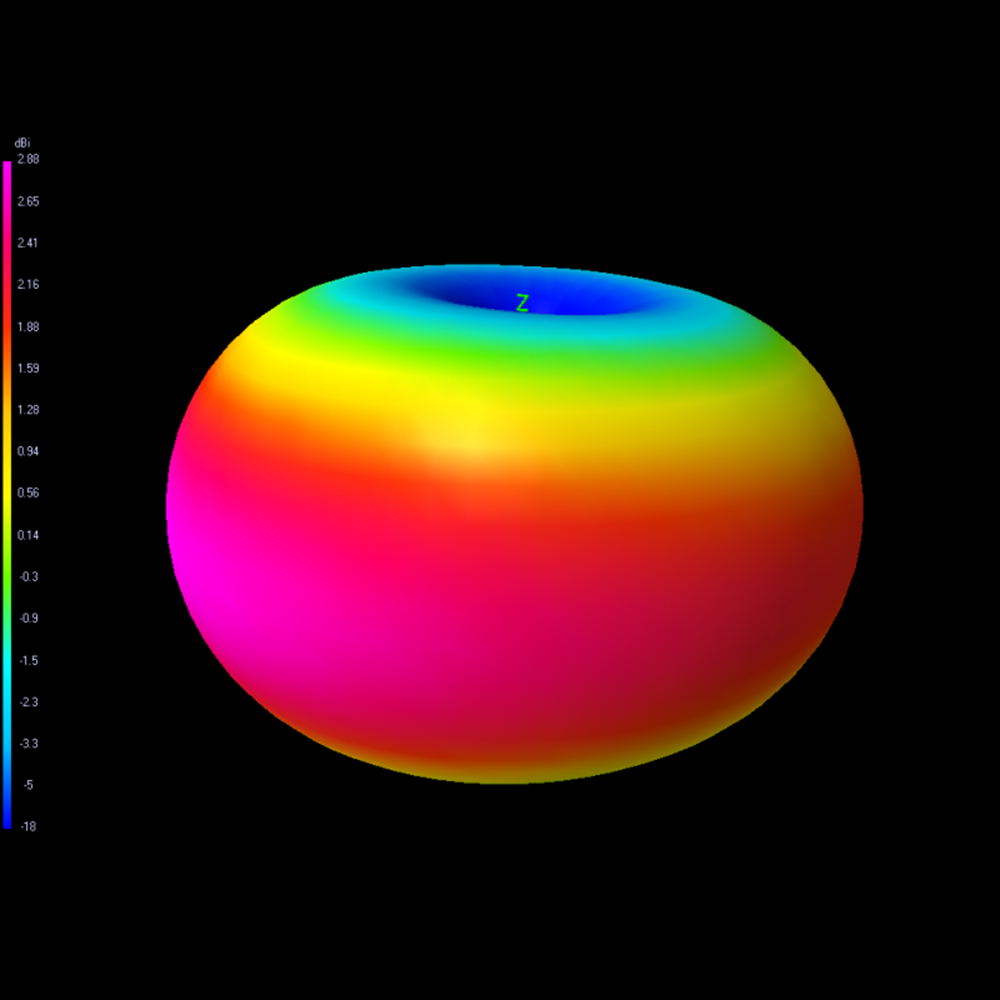

I've found it helpful to visualise antenna patterns as 3D shapes surrounding your transmitter and receiver. Once you understand these patterns, you can position your antennas to ensure their strongest coverage areas align with your flying area, while keeping null zones pointed away from where you'll be flying.
Frequency-Specific Considerations
Different control frequencies have unique characteristics that I've observed through extensive testing:
2.4GHz Specifics
- Shorter wavelength means smaller antennas
- More affected by obstacles than lower frequencies
- More susceptible to water absorption (rain, humidity)
- More directional by nature
- More common interference sources (WiFi, Bluetooth)
2.4GHz systems perform exceptionally well in open areas but struggle with penetration. I've had 2.4GHz links drop completely when flying behind dense foliage or buildings, while lower frequency systems maintained solid connections. However, the compact antennas make 2.4GHz ideal for smaller builds.
900MHz/868MHz Specifics
- Better penetration through obstacles
- Larger antennas required for optimal performance
- Less affected by moisture
- Different legal restrictions by region
- Less crowded spectrum in most areas
900MHz has become my go-to frequency for most flying. It offers a perfect balance of range, penetration, and antenna size for 5" and larger builds. The performance difference compared to 2.4GHz is most noticeable when flying in areas with obstacles or at the edge of visual range.
433MHz Specifics
- Best penetration and diffraction around obstacles
- Very large antennas required
- Strict legal restrictions in many regions
- Lowest data bandwidth but excellent range
- Least affected by environmental factors
For extreme long-range missions, nothing beats 433MHz. I've maintained solid control links at distances where the drone was barely visible, even with modest antenna setups. The challenge is accommodating the large antennas and navigating the varying legal restrictions across different regions.
Custom and DIY Antennas
Some advanced users build their own control antennas:
- Quarter-wave ground plane antennas: Simple, effective designs
- Dipole antennas: Basic but reliable when properly constructed
- Moxon antennas: Compact directional options
- Yagi antennas: High-gain directional designs
- Helical antennas: Circular polarized directional options
DIY antennas require precise measurements based on frequency:
- 2.4GHz quarter-wave: ~31mm element
- 900MHz quarter-wave: ~83mm element
- 433MHz quarter-wave: ~173mm element
I've built dozens of DIY antennas over the years, and while commercial options have improved dramatically, there's still value in custom builds. My DIY ground plane antennas for 900MHz outperform many commercial options at a fraction of the cost. The key is precise measurements and quality materials.
Antenna Tracking Systems
For extreme long-range applications, antenna trackers automatically point directional antennas:
- GPS-based tracking: Uses coordinates from telemetry
- RF tracking: Uses signal strength to determine direction
- Combined systems: Multiple data sources for accuracy
- Manual tracking: Simple rotator with manual control
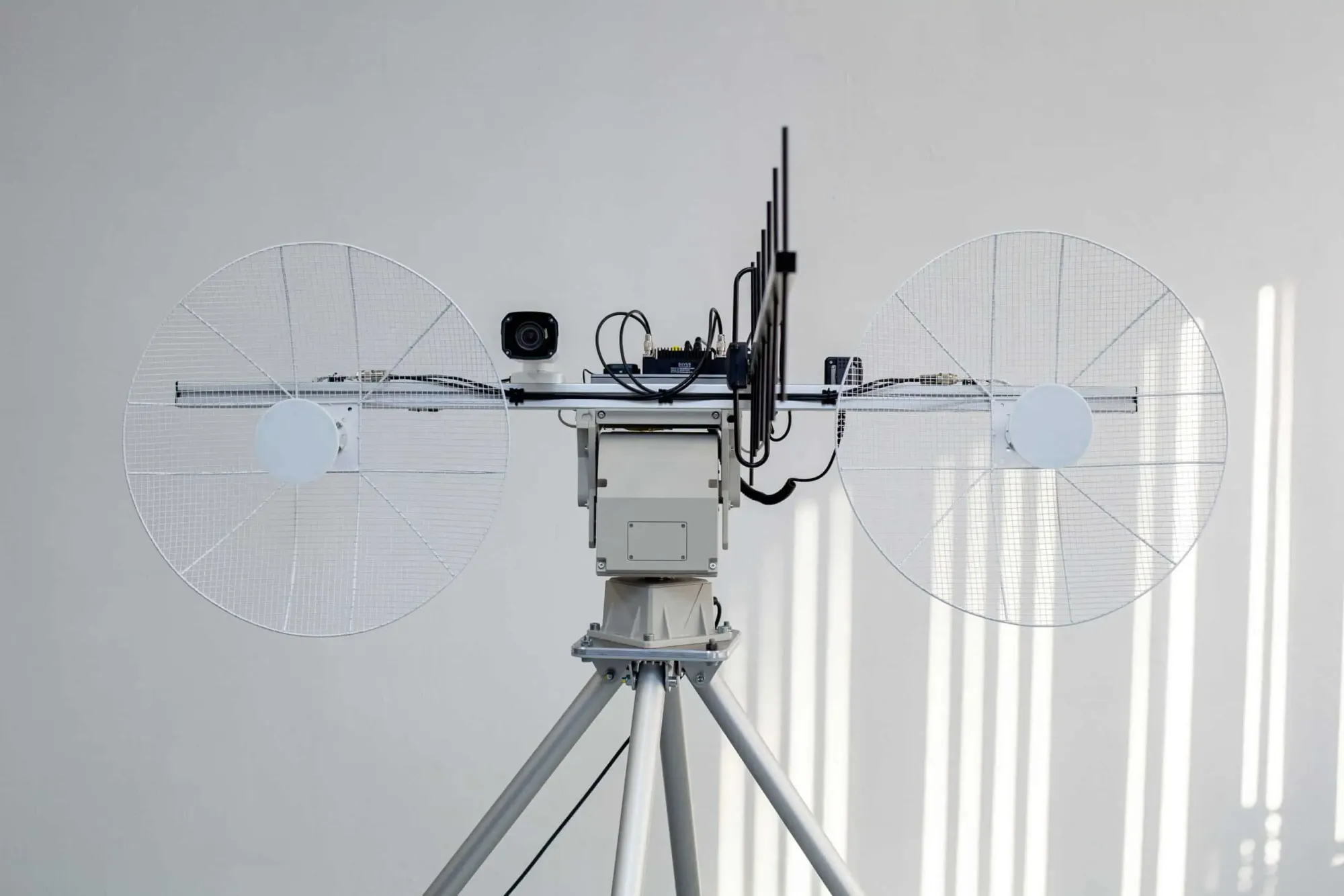
An antenna tracker transformed my long-range capabilities. With a high-gain directional antenna on a tracker, I've maintained solid control links at distances where an omnidirectional setup would have failed completely. For serious long-range flying, a tracker is worth the investment.
Troubleshooting Antenna Issues
Even the best antennas can develop problems. Here's how to diagnose and address common issues I've encountered over years of flying.
Common Problems and Solutions
Poor Range
Potential causes:
- Damaged antenna
- Improper antenna orientation
- Connector issues
- Interference from other components
- Suboptimal antenna placement
Solutions:
- Inspect antennas for physical damage
- Reorient antennas for better coverage
- Check and secure all connections
- Relocate antennas away from interference sources
- Consider upgrading to better antennas
When diagnosing range issues, I always start with the connectors. A loose U.FL connector can reduce range by 80% or more while looking perfectly normal to the naked eye. A gentle tug test on each connection often reveals problems that visual inspection misses.
Inconsistent Performance
Potential causes:
- Multipath interference
- Antenna position shifting during flight
- Intermittent connector issues
- Orientation-dependent nulls
- Environmental factors
Solutions:
- Implement diversity antenna systems
- Secure antennas more effectively
- Check and reinforce connections
- Reposition antennas to minimize null effects
- Adjust flying style to account for environmental factors
I once chased an intermittent control issue for weeks before discovering that vibration was causing a receiver antenna to gradually shift position during flight. A small dab of hot glue to secure the antenna solved the problem completely. Never underestimate the impact of mechanical factors on RF performance.
Failsafes and Signal Loss
Potential causes:
- Damaged antennas
- Connector issues
- Interference from other systems
- Exceeding practical range
- Antenna nulls pointed at receiver
Solutions:
- Replace damaged antennas
- Secure or replace connectors
- Change frequency or channel
- Stay within proven range limits
- Be aware of antenna radiation patterns during flight
Failsafes often occur in specific locations or during specific maneuvers. I keep a mental map of where signal issues occur and adjust my flying accordingly. If you experience repeated failsafes in the same area, it's likely due to environmental factors like interference or signal reflection rather than equipment issues.
Testing and Verification
Several methods can help evaluate antenna performance:
- Range testing: Methodically test maximum usable range
- RSSI/LQ monitoring: Track signal strength during flight
- Comparison testing: A/B testing different antennas
- Failsafe testing: Verify behavior at range limits
I perform a simple range test before every significant flying session: I walk away from my drone with the throttle armed at minimum until I reach about 50% of my expected maximum range, then return. This quick test has saved me from numerous equipment issues that would have resulted in lost drones.
When to Replace Control Antennas
Antennas should be replaced when:
- Visible physical damage is present
- Range has noticeably decreased
- Connections are loose or damaged
- Regular failsafes occur despite proper setup
- Upgrading to a better control system
I replace my receiver antennas preventatively after any significant crash, even if they look undamaged. The cost of a new antenna is trivial compared to the cost of a lost drone. I've found that antennas can have internal damage that's not visible externally but significantly impacts performance.
Pro Tips for Control Antenna Optimization
These advanced techniques can help you get the most from your control system antennas. I've developed these approaches through years of testing and real-world flying.
Frequency Management
- Choose less congested bands when possible
- Consider regional restrictions on frequency and power
- Use spectrum analyzers to identify interference
- Coordinate frequencies when flying with others
When flying in urban areas, I've found that 900MHz systems often outperform 2.4GHz not because of their theoretical range, but because they're less affected by the countless WiFi networks and Bluetooth devices that saturate the 2.4GHz spectrum. A spectrum analyzer can be eye-opening—in some urban areas, the 2.4GHz band is so congested that it's amazing our control systems work at all!
Environmental Adaptations
- Urban environments: Consider higher gain antennas and diversity
- Long range over water: Be aware of reflection effects
- Flying in rain: Expect some range reduction with 2.4GHz
- High altitude: Enjoy increased range due to better line of sight
Water is a fascinating challenge for RF signals. I've experienced both dramatically increased range when flying over calm water (due to signal reflection) and sudden signal loss when those reflections cause destructive interference. When flying over water, I maintain a higher altitude than usual to minimize these effects.
Competitive Advantages
- Race preparation: Verify antenna condition before races
- Backup antennas: Carry spares for quick replacement
- Pre-flight checks: Verify antenna orientation and condition
- Signal strength logging: Track performance over time
At competitive events, I've seen pilots lose races due to preventable antenna issues. I always perform a quick range check before important flights, and I carry pre-tuned spare antennas that I can swap in seconds if needed. This preparation has saved me more than once when I've damaged an antenna during practice.
Long-Range Optimization
- Frequency selection: Lower frequencies travel farther
- Antenna gain: Higher gain directional antennas extend range
- Diversity implementation: Multiple antennas for reliability
- Redundant systems: Consider backup control links
For my most extreme long-range builds, I actually run dual control systems—typically ExpressLRS at 900MHz as primary and a separate 433MHz system as backup. The weight penalty is minimal compared to the peace of mind, and I've had flights where switching to the backup system allowed me to recover a drone that would otherwise have been lost.
For more detailed information on long-range flying, see:
Long-Range Flying and Extended FPV Drone Operations
FAQ: Common Questions About Control System Antennas
What's the difference between control and video antennas?
Control antennas operate on different frequencies (typically 2.4GHz, 900MHz, or 433MHz) than video antennas (typically 5.8GHz). Control antennas prioritize reliability and consistent coverage, while video antennas often prioritize bandwidth. Control antennas are also generally larger due to the lower frequencies used.
In my experience, control antennas can be simpler than video antennas because they don't need to handle the high bandwidth requirements of video transmission. This often means better efficiency and range for the same size.
For more detailed information on RC antennas, see:
Overview of FPV Antennas
Do I need to match my transmitter and receiver antennas?
While not strictly necessary, matching antenna types and polarization between transmitter and receiver provides optimal performance. At minimum, ensure both use the same polarization (linear or circular) and are designed for the same frequency band.
I've tested mismatched setups extensively, and while they can work, you're typically leaving 20-30% of your potential range on the table. It's worth taking the time to ensure your antennas are properly matched.
How important is antenna orientation?
Extremely important. Improper orientation can reduce range by 50-90%. For linear polarized antennas, the orientation should match between transmitter and receiver. For diversity setups, receiver antennas should be positioned at 90° angles to each other to provide coverage in multiple orientations.
I once helped a pilot who was experiencing terrible range—less than 100 meters before failsafe. The issue? Both receiver antennas were zip-tied parallel to each other, creating a massive blind spot. Simply repositioning one antenna to 90° from the other instantly increased their range to over 1km.
Can I cut or modify my control antennas?
Generally not recommended. Control antennas are precisely tuned to specific frequencies, and modifications can significantly degrade performance. If size is an issue, look for purpose-built compact antennas designed for your specific system rather than modifying existing ones.
That said, I've had situations with micro builds where I've had to shorten antennas to fit the frame. When doing this, I try to maintain at least 50% of the original length and ensure proper orientation. The performance hit is noticeable but sometimes necessary for extremely compact builds.
How much range improvement can I expect from antenna upgrades?
This varies widely depending on your starting point and the specific upgrade, but:
- Upgrading from damaged antennas: 50-200% improvement
- Upgrading from stock to quality antennas: 20-100% improvement
- Adding diversity: 10-50% improvement in challenging environments
- Switching to directional antennas: 100-500% improvement in specific directions
The most dramatic improvement I've personally experienced was switching from a stock omnidirectional antenna to a high-gain directional antenna on a 900MHz system, which increased my usable range from about 3km to over 15km in open terrain.
Should I use circular polarized antennas for control?
While circular polarization is standard for video systems, it's less common for control. Circular polarization helps with multipath interference but comes with approximately 3dB (50%) loss in signal strength compared to perfectly aligned linear antennas. For most control applications, linear polarization provides better efficiency, though circular can be beneficial in environments with significant multipath issues.
I primarily use linear polarization for control links, but I've found circular polarization valuable when flying in urban environments with lots of signal reflections, or when doing aggressive freestyle where the drone's orientation changes rapidly.
What's the best antenna setup for maximum range?
For absolute maximum range:
- Use the lowest frequency system practical (433MHz if possible)
- Implement a high-gain directional antenna on the transmitter (Yagi or helical)
- Use a tracking system to keep the directional antenna aimed at the drone
- Ensure the receiver antenna is high-quality and properly oriented
- Maintain clear line of sight whenever possible
My personal long-range setup uses a 433MHz system with a 10dBi Yagi antenna on a GPS-based tracker, paired with a simple but properly oriented dipole on the drone. This combination has provided reliable control at distances beyond 30km in ideal conditions.
How do carbon fiber frames affect control antennas?
Carbon fiber blocks and reflects RF signals, creating "shadows" and potential interference. To minimize these effects:
- Keep antennas away from carbon fiber parts
- Route antennas through non-conductive frame elements
- Use antenna tubes to position antennas away from the frame
- Consider diversity setups to provide multiple signal paths
I've measured up to 80% signal reduction when an antenna is placed directly against carbon fiber. Even a few millimeters of separation can dramatically improve performance. For carbon frames, I always use antenna tubes or mounts that position the antennas at least 10-15mm away from the carbon fiber.
Conclusion
Control system antennas are the critical link between pilot and drone, directly impacting range, reliability, and overall flying experience. By understanding the different types of antennas, their characteristics, and how to properly install and optimize them, you can significantly improve your control link performance.
Whether you're racing at the local track, capturing cinematic footage, or exploring long-range capabilities, the right antenna setup can make the difference between a successful flight and a failsafe at a critical moment. Don't underestimate the importance of this often-overlooked component of your FPV system.
Remember that the perfect antenna setup depends on your specific needs, flying style, and environment. Don't be afraid to experiment with different configurations to find what works best for you, and always carry spare antennas—they're relatively inexpensive insurance against lost drones.
In my years of flying, I've learned that attention to these seemingly small details often makes the biggest difference in performance and reliability. A thoughtfully selected and properly installed antenna system will serve you well and might just save your drone one day.

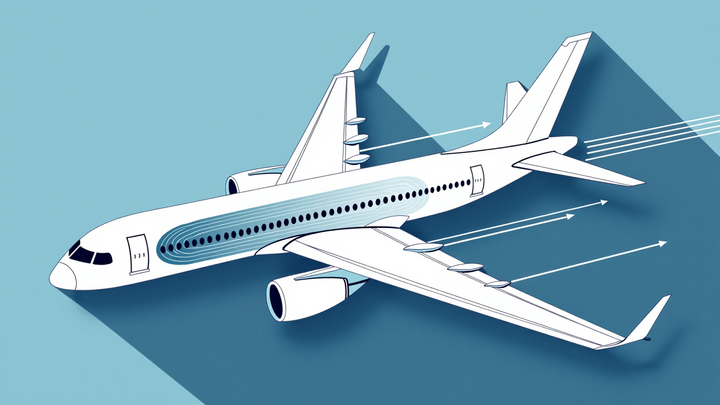

Comments ()